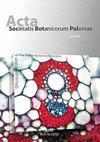园艺和组织培养方法在濒危报春花迁地保护中的应用。
IF 0.8
4区 生物学
Q3 PLANT SCIENCES
引用次数: 4
摘要
本研究旨在积极保护波兰濒危植物报春花(Primula farinosa)的最后一个栖息地,并在组织培养条件下通过种子繁殖和植物繁殖进行评估。结果表明,赤霉素酸(GA3)是促进小麦种子萌发的关键因子。幼苗在18/16℃昼夜控制温度下生长,可获得无菌根的优质植株材料。在组织培养中,最有利于芽部繁殖的培养基是MS,培养基中添加最低浓度的吲哚-3-丁酸(IBA);0.05 mg dm−3)和6-苄基氨基嘌呤(BAP;0.1 mg dm−3)。所有生长素的生根能力都很高,且具有可比性。在离体培养过程中,种子源性和微繁殖植株的2C DNA含量没有变化。在一项为期2年的研究中,对种子和组织培养的植物进行了比较。在所有比较的特征中,只有在观察第一年,微繁殖植株的每花序花数低于种子源植株。这种差异是短暂的,在研究的第二年没有观察到。建立了有效的体内和体外繁殖方案,可用于实际的物种保护。本文章由计算机程序翻译,如有差异,请以英文原文为准。
Application of Horticultural and Tissue Culture Methods for Ex Situ Conservation of Endangered Primula farinosa L.
Our study aimed at active conservation of the last location of Primula farinosa, an endangered species in Poland, and assessed reproduction by seeds and plant propagation on sterile media in tissue culture conditions. We identified gibberellic acid (GA3) as the key factor stimulating germination of P. farinosa seeds. Growing juvenile plants under controlled temperature of 18/16 °C day/night yielded good quality plant material without mycorrhization. In tissue culture, the most favorable medium for shoot propagation was MS supplemented with the lowest tested concentration of indole-3-butyric acid (IBA; 0.05 mg dm−3) and 6-benzyl-aminopurine (BAP; 0.1 mg dm−3). The rooting ability of shoots was high and comparable for all auxins used. 2C DNA content of seed-derived and micropropagated plants did not indicate any change in the ploidy level during in vitro cultivation. Plants derived from seeds and tissue cultures were compared in a 2-year study. Of all the characteristics compared, only the number of flowers per inflorescence was lower for micropropagated plants when compared with the seed-origin plants in the first year of observation. The difference was of transient nature and was not observed in the second year of the study. Effective protocols for in vivo and in vitro propagation of P. farinosa were developed, which can be used in practical species protection.
求助全文
通过发布文献求助,成功后即可免费获取论文全文。
去求助
来源期刊
CiteScore
2.00
自引率
10.00%
发文量
18
审稿时长
1 months
期刊介绍:
The journal has been published since 1923 and offers Open Access publication of original research papers, short communications, and reviews in all areas of plant science, including evolution, ecology, genetics, plant structure and development, physiology and biochemistry.

 求助内容:
求助内容: 应助结果提醒方式:
应助结果提醒方式:


